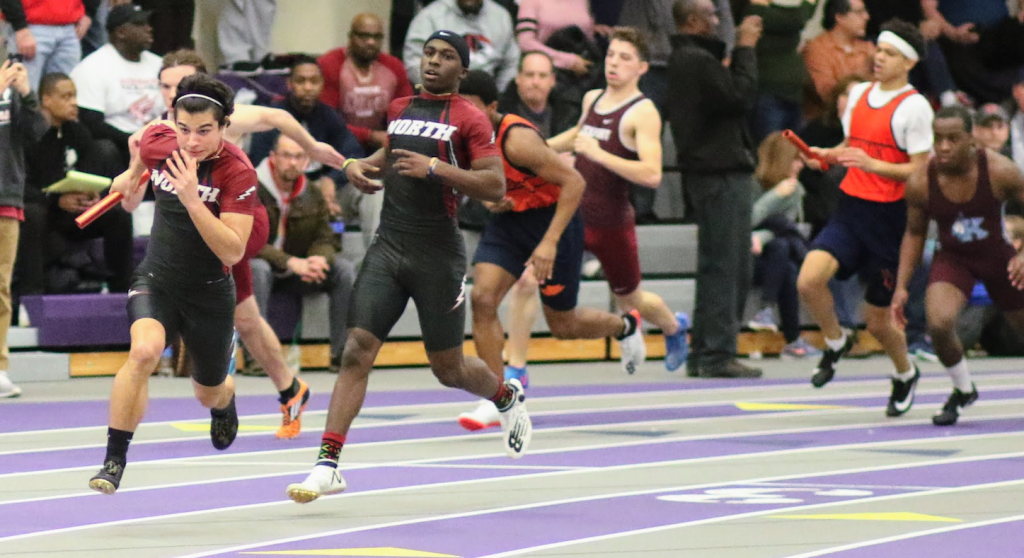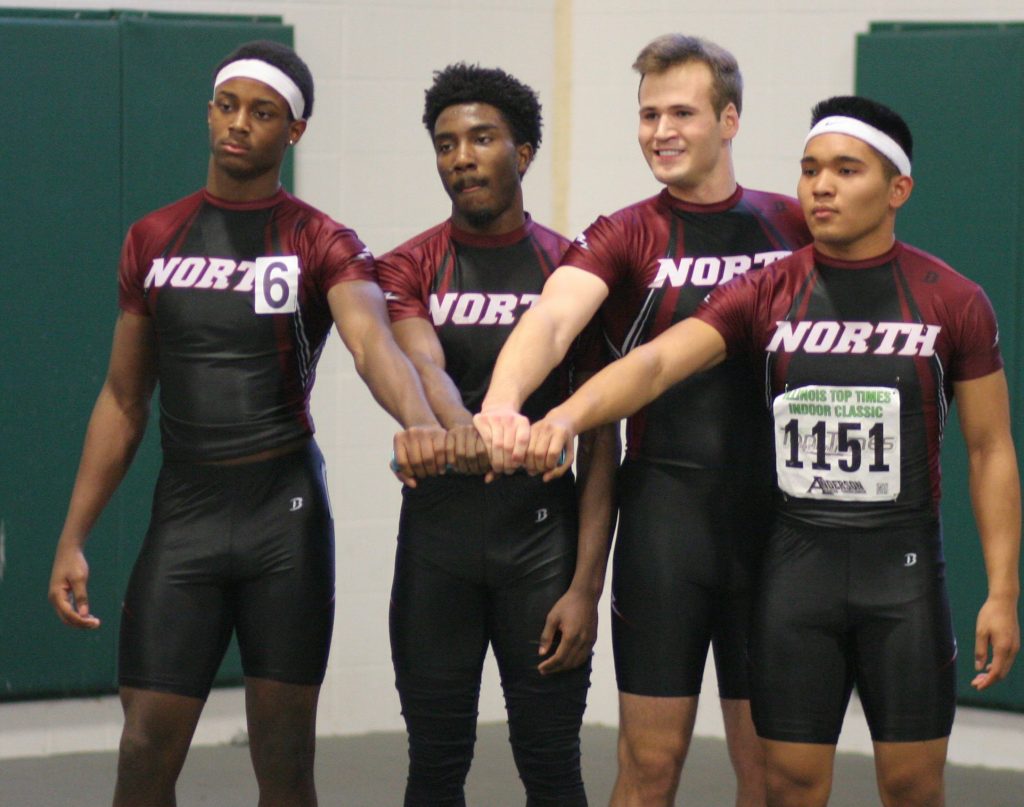
I’m Done With Blind 4×2 Handoffs
4×2 is a strange event, made stranger by its placement in the Illinois order of events. Only around half the states include the 4×2 as an official high school event. Georgia is a recent newcomer to the 4×2. It’s not an official event in college. Many distance coaches hate the 4×2 because the 4×2 makes track too “sprint heavy”. Want to make a distance coach’s day? Ask them about the DMR (Distance Medley Relay).
With the 400 and 300h following our 4×2 in Illinois, we have a revolving door of sprinters participating in the event. Combine the interchangeable nature of the four runners and the impossibility of practicing exchanges at the required fatigue of the incoming runner and required excitement of the outgoing runner… it’s a shitshow.
It’s such a shitshow that I’ve stopped publishing outdoor 4×2 relay splits. Bad handoffs, early handoffs, or late handoffs make split times a joke. (Indoor split times are legit because the handoffs are better and you can easily see the 200m lap line.)
In 2018, Plainfield North won the 4×2 at the IHSA State Meet with a time of 1:26.17. In spite of our successful race, we had one handoff that still haunts me. I believe it cost us a full second and kept us from breaking the IHSA state record, 1:25.83 by Cahokia.
With three meet cancellations in 2018, we only had 11 opportunities to run the 4×2. At one meet we did not enter a team in the race (a weekday meet where we wanted to get our sprinters an open 400m time). TEN different guys ran in the ten varsity 4x2s for us in 2018.
Registe 8/10
Hanneman 7/10
Stiffend 5/10
Moore 5/10
Bownes 5/10
Anderson 3/10
Docks 2/10
Fisher 1/10
Capezio 1/10
S. Pearson 1/10
Oliver Fisher and Anthony Capezio were usually busy in the 400, keeping them out of the 4×2. In addition, hurdlers Jalyn Givan and Kyle Burke could have factored into the race but they were mainstays in the 300 hurdles.
How can you work on precise execution when TEN different guys are interchangable?
If the state champions in 4×2 in 2018 had trouble with 4×2 handoffs, how about lesser teams?
For 40 years, my approach has been… keep the 4×2 on the same page as the 4×1. Lane ownership was inside, outside, inside, outside. The baton went right to left to right to left. If someone ran on our 4×1, they would run the same leg in the 4×2. We went with a generic mark of 5m (5 big steps), using the start of the 30m exchange zone as the go mark (no tennis balls needed). We coached our incoming runner to FINISH and run through the entire zone, making sure he did not come to a stop until well out of the zone. The outgoing runner was coached to leave “BIG & STRONG”, never leaving like a bat out of hell.
14 times in my 30 years as a head track coach, my teams won 4×2 medals at the state meet (three different schools, two different states). My teams won the state 4×2 three times. In 2001, my Harrisburg team set the IHSA Class A state record running 1:28.06. In the prelims of 2001, we were so dominant in the small school division that we played it safe and did open exchanges (like a fast 4×4, not blind like a 4×1). We still ran the fastest prelim time, over one second faster than the second best time.
The poor execution of 4×2 exchanges have caused me, in my advanced years, to hate the 4×2. At most meets, it’s a JV race… a collection of guys not fast enough to run the 4×1, 400, or 300 hurdles. Because splits are bogus, it’s an unmeasured performance for our sprinters. Sucks. When an exchange or two goes horribly wrong, I want to vomit. Just thinking about it makes me sick.
Enjoying an Old Fashioned with Brian Kula in the basement of Brian’s Denver home, I mentioned my hatred of the 4×2. Brian said he prefers an open exchange in the 4×2. The fact that Brian Kula’s team (Valor Christian H.S.) has achieved a 1:25.41 in the 4×2 with open exchanges tells me that Brian is onto something. Brian Kula’s teams hold BOTH the girl’s and boy’s Colorado state records in the 4×2.
A few weeks ago in a long phone conversation with Brendan Thompson, Brendan told me that they did open exchanges at the University of Iowa when given a 4×2 opportunity. IOWA RAN 1:23.02 WITH OPEN HANDOFFS. Why can’t high school teams run fast with safe exchanges? Why do we have to suffer through humiliating handoffs and flawed splits?
I thought back to the prelims in 2001 when my team executed open exchanges with precision and no noticeable slow-down.
Then I thought about how well we run the 4×2 indoors.
The chaotic exchange zones of the indoor 4×2 (so chaotic, they are dangerous), forces teams to do open exchanges. Another factor: only the first runner stays in his lane, the second, third, and fourth runner dive to lane one right after the handoff. By the way, always run your best sprinter FIRST in the indoor 4×2. It’s hugely advantageous to hold the lead in the indoor 4×2. Only the team in the lead gets to stay in lane one for the 2nd and 3rd exchange.

The team in the picture above ran splits of 22.4 (Carlos Baggett), 22.7 (Hunter Houslet), 23.1 (Jordan Gumila), and 22.7 (Joe Stiffend). Because our handoffs were safe and perfect, those splits are 100% legit. Interesting, the two fastest guys on our team didn’t run in that relay. DeVaughn Hrobowski (10.99 and 21.94 the previous year as a junior) was ineligible and Clay Payson (anchored our 2016 IL #2 4×1 team, 41.72, in 2016) was at a lacrosse game.
I’ve seen teams do blind handoffs in the indoor 4×2 but if you are not the dominant team in the race, IMO, it’s dumb. Too much chaos. Too many disasters.
I decided to research my team’s indoor 4×2 times in the past ten years, two Covid years excluded (we haven’t had an indoor meet in almost 24 months).
Here are ten years of indoor 4×2 times at Plainfield North H.S. (we are a new school, we’ve graduated only 14 classes beginning in 2008). 2500 students attend PNHS, the 79th biggest school in Illinois.
2010 – 1:34.89
2011 – 1:33.23
2012 – 1:31.79
2013 – 1:35.08
2014 – 1:32.97
2015 – 1:33.19
2016 – 1:31.19 (IL #1)
2017 – 1:31.69
2018 – 1:31.43
2019 – 1:31.65
Our ten year average is 1:32.71 which might be the best ten year average in Illinois. I’m fairly certain, our five year average of 1:31.83 would be IL #1.
All the times above were accomplished on FLAT tracks, not banked.
All the times above were accomplished with fast open-exchanges. I don’t recall any dropped batons, disqualifications, or embarrassing exchanges. I don’t even remember the baton ever slowing down. Not once did I get sick to my stomach.
This is where it gets interesting. Brian Kula believes his teams have a good chance to run FIVE SECONDS FASTER outdoors at the end of the season than they ran indoors on a flat track… open exchanges indoors, open exchanges outdoors.
Why shouldn’t Plainfield North hand off the same outdoors as we do indoors?
If Brian Kula’s five second conversion is correct, our 1:31.83 indoor average would translate to a 1:26.83 outdoor average.
In the past five years, the AVERAGE time of the IHSA 3A 4×2 State Champion is 1:26.94.
I’ll take my chances every year with a potential 1:26.83.
I’m looking forward to the 4×2 this year.

So, how do you do this? The incoming runner is going to be significantly faster at the end of the 200 than the 400 so do you just leave earlier? Set a mark but still look at them? Not sure how you perform the mechanics of this exchange? I’m in Georgia and we are running this event this year but I’ve never coached it before.
I guess I didn’t address the “how”. First of all, we do it indoors for the 4×2, so it’s like second nature. Like all things, it must be practiced. Incoming still comes in fast, outgoing leaves “big and strong”. Incoming always inside with baton in right. Outgoing always outside, left hand receives baton high (reach for face, hand makes an upward “V”), switch baton left to right on the curve. Start outgoing at start of 30m zone. Run fastest guy anchor… probably only guy who will run over 200m. The open, visual exchange gives outgoing runner the chance to gauge speed of incoming. The generic “go mark” is about five meters but kids that practice this is will just figure it out. My best guys will turn and sprint 3-4 steps before twisting with hand back and high. Outdoor you have 30m… indoor only 20m (4×4 also 20m). Lots of room for adjustments.